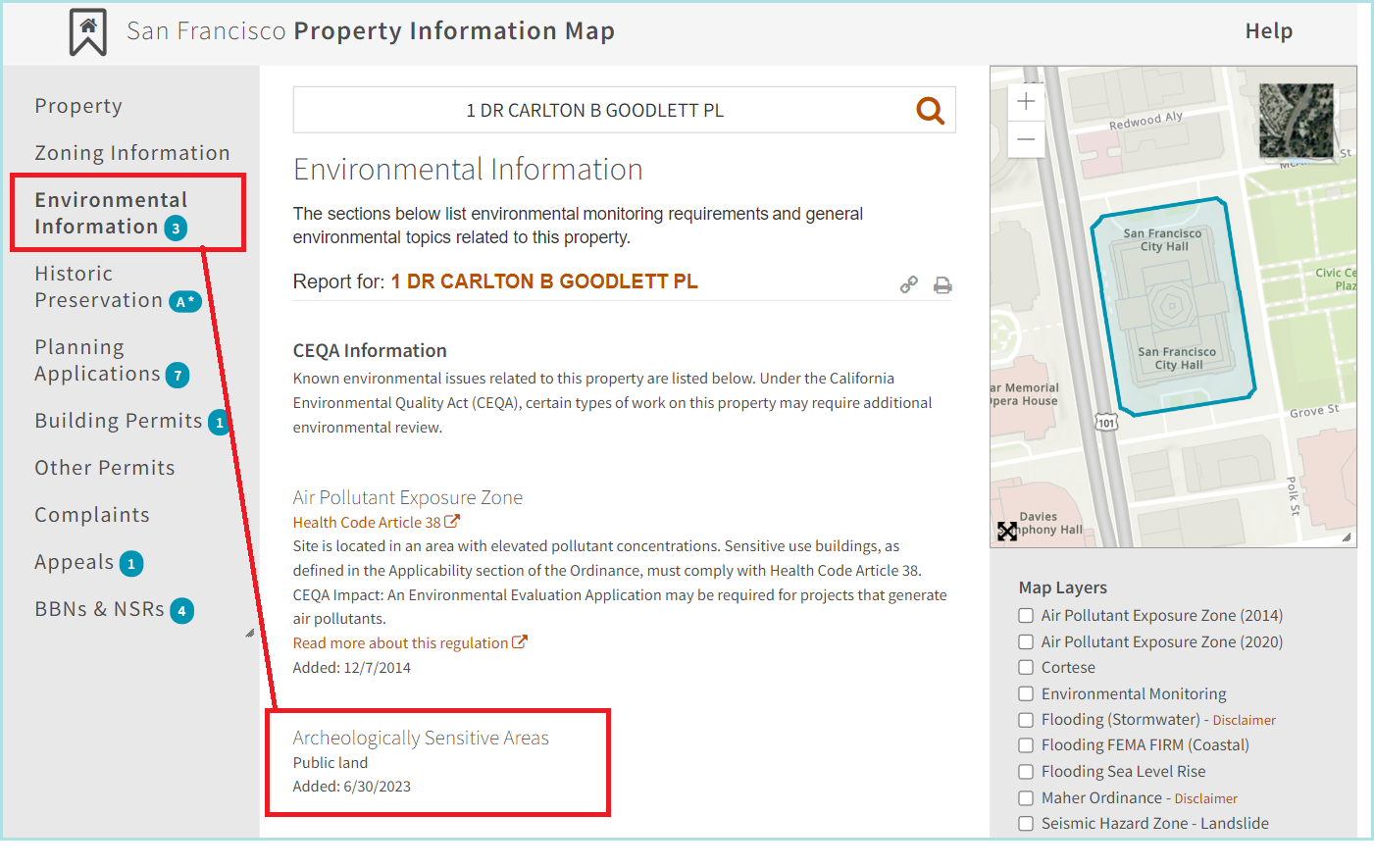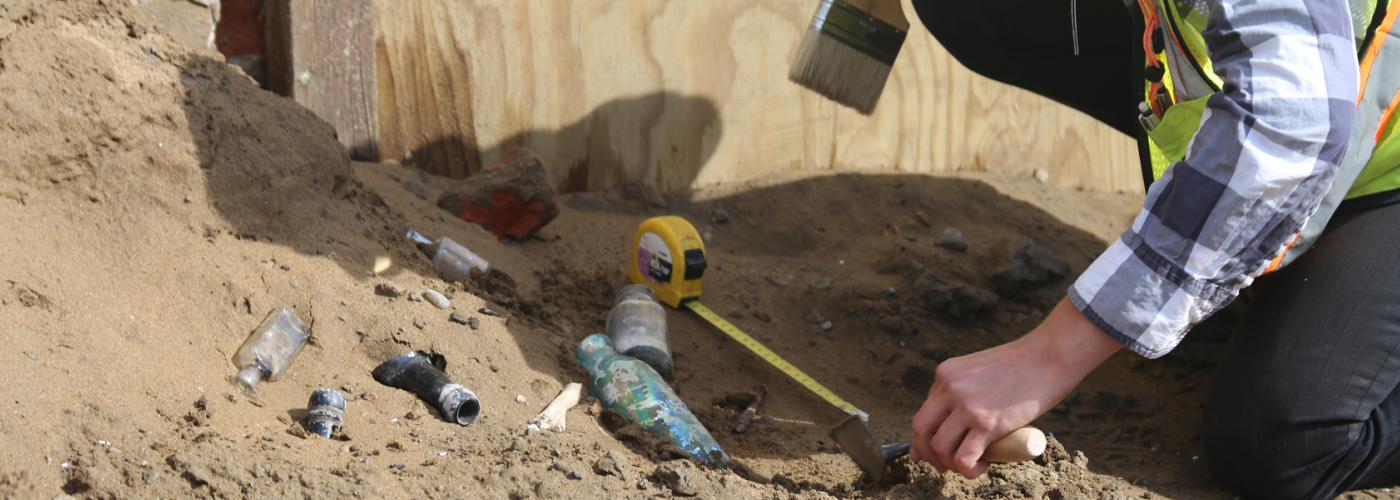Archaeological Review
Land Acknowledgement
We acknowledge that we are on the unceded ancestral homeland of the Ramaytush Ohlone, who are the original inhabitants of the San Francisco Peninsula. As the indigenous stewards of this land and in accordance with their traditions, the Ramaytush Ohlone have never ceded, lost, nor forgotten their responsibilities as the caretakers of this place, as well as for all peoples who reside in their traditional territory. As guests, we recognize that we benefit from living and working on their traditional homeland. We wish to pay our respects by acknowledging the Ancestors, Elders, and Relatives of the Ramaytush Ohlone community and by affirming their sovereign rights as First Peoples.
What Is Archaeology?
Archaeology is the study of things people left behind to learn about people in the past. Archaeologists make interpretations about the past by recovering and analyzing a wide variety of materials that humans made and used.
Items like bone and stone tools, shell beads, pottery, and glass bottles can tell archaeologists about how people once lived. These pieces of evidence can help answer questions about the recent and distant past and help tell unremembered stories about the people who once lived here.
Archaeologists can make more informed interpretations about the past when they are able to accurately recover and record what’s been left behind, giving everyone a better understanding of our collective history.
Why Do Archaeologists Work in San Francisco?
The California Environmental Quality Act (CEQA) is a state law that requires government agencies to inform decision makers and the public about environmental impacts that could be caused by proposed construction projects. The San Francisco Planning Department is responsible for analyzing how development projects could impact the environment. CEQA requires analysis of many different aspects of the environment including things like air and water quality as well as tribal cultural resources (objects or places with cultural value to California Native Americans) and cultural resources. Cultural resources includes archaeological resources along with historic buildings, landscapes, and structures.
The San Francisco Planning Department has staff with expertise in archaeology and who consult with local Ohlone representatives and other representatives of the city’s rich cultural history. They conduct a Cultural Resource Review to determine if a proposed development project could damage or destroy important archaeological or tribal cultural resources. In an urban environment like San Francisco it is challenging to know for certain where archaeological resources will be located because most of these remnants are buried beneath buildings and city streets.
Planning department staff use geology, topography, historical maps, and a wide variety of historical and archival information to better understand where past peoples lived and how they modified and left their trace on the environment. All these factors help determine if a development project is located in an area where archaeological resources are likely to be encountered. If Planning Department staff determine that a proposed development project could impact important archaeological resources, the proposed project must comply with measures that may require protection or archaeological investigation of the potential resource in order to reduce the project’s impact to such resources.
Planning’s Process Improvements for Archaeology Analysis
The San Francisco Housing Element 2022 Update prompted the Planning Department to implement a process improvements including efforts to streamline environmental review of proposed projects while providing more transparency into the department’s review processes. As part of this undertaking, the department has refined the archaeological review process. These efforts include updating and refining the archaeological sensitivity zones identified for the City.
Previously, the Planning Department had divided the City into two archaeological zones. One zone consisted primarily of the locations of known archeological sites and some locations previously determined as having high archeological sensitivity. Any proposed project with ground disturbance to a depth of two feet or more below ground surface triggered archaeological review within those areas. For the other zone, archeological review was triggered for proposed projects in all other areas of the City if there was ground disturbance to a depth of 8 feet or more.
The Planning Department has refined these archaeological sensitivity zones to improve the cultural resource screening process and reduce unnecessary reviews for low to moderately sensitive areas in San Francisco. The screening criteria now considers both the depth and the amount of ground disturbance to ensure that projects with minimal ground disturbance are not unnecessarily requiring review.
These refined zones also ensure that project sponsors have a clear understanding of the archaeological sensitivity of their project area.
Improved Archaeological Sensitivity Zones
Planning Department’s archaeological staff have identified four zones of archaeological sensitivity for the city:
- Zone 1: areas that have high sensitivity for archaeological resources that are at or just beneath the current ground surface.
- Zone 2: areas that have high sensitivity for archaeological resources that are more deeply buried beneath the current ground surface.
- Zone 3: areas that have moderate to low sensitivity for archaeological resources. This zone also encompasses areas that have high sensitivity for deeply buried resources that were submerged in the waters of the San Francisco Bay over the last 10,000 years.
- Public: publicly owned property, which is subject to a different review pathway.
To identify which archaeological zone your property is located within, you can find this information on the San Francisco Property Information Map. Enter the project address or parcel in the search bar, then click the “Environmental Information” tab in the left-hand navigation column. Then scroll down to the “Archeologically Sensitive Areas” section under CEQA Information and the zone or zones will be listed.

What Does This Mean for Your Project?
The amount of ground disturbance proposed by a development project and the archaeological sensitivity of the development site as identified in the above zones may result in the Planning Department’s cultural resources staff review of your project. Each zone has criteria that staff will use to screen whether archaeological review is required.
The screening criteria is different for each zone because each zone is related to a range of expected archaeological resources and their anticipated depth. For example, Zone 1 is where significant archaeological resources would be expected to be shallower, so shallower ground disturbance from a proposed construction project is more likely to disturb or destroy significant resources within this zone.
Zone Criteria for Project Review
The three zones (Zones 1-3) have different criteria for when a project will require review by the Planning Department’s cultural resource staff, which are outlined below. *
Zone 1
- 2 feet or deeper ground disturbance1, and
- more than 25 cubic yards of ground disturbance.
Zone 2
- 5 feet or deeper ground disturbance, and
- 50 cubic yards or greater of ground disturbance, and
- an alteration project on a parcel that is 3,000 square feet or greater.
Zone 3
- Mass excavation, deep foundations, and/or ground improvement reaching a depth of 15 feet or deeper; or
- has more than 1,500 cubic yards of ground disturbance; or
- development footprint greater than or equal to 10,000 square feet and any ground disturbance greater than or equal to 10 feet deep; and
- an alteration project on a parcel that is 3,000 square feet or greater.
* All depths refer to depth below the existing ground surface.
If Criteria are Met
If the proposed project meets the above criteria, the cultural resources staff at the Planning Department will review the proposed project. Unless staff have additional questions about the depth or location of ground-disturbing work, no additional information is needed from the project sponsor.
Based on initial review, cultural resources staff may determine that the proposed development project is unlikely to result in damage or destruction of significant archaeological resources. In this case, no further archaeological review is required.
For development projects that meet the criteria requiring archaeological review that otherwise could be approved by Planning Staff at the Planning Information Counter (PIC), please follow up with PIC staff to determine if the project can still be approved over the counter.
For projects that may result in the damage or destruction of significant archaeological resources, additional environment review may be undertaken by the department’s cultural resources staff, as required under CEQA.
This review may be documented in environmental review documents, such as General Plan Evaluations, Mitigated Negative Declarations, or Environmental Impact Reports.
The outcome of this review may be the identification of measures, referred to as mitigation measures, which would lessen the impact to significant archaeological resources that may be disturbed or destroyed by project construction activities. Cultural resource mitigation measure can include requirements for project sponsors to hire a qualified archaeological consultant to look for and document buried traces of the past, to engage with local Native American tribal members to ensure that resources are appropriately treated, and to ensure that significant cultural resources are interpreted for the public.
For More Information
For additional information on the City’s archaeological sensitivity zones or the Planning Department’s cultural resources review process, please contact Allison Vanderslice at allison.vanderslice@sfgov.org or cpc.archeology@sfgov.org.

